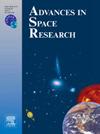风切变条件下冬季雷暴上方中间层可能出现萌芽的区域的数值模拟
IF 2.8
3区 地球科学
Q2 ASTRONOMY & ASTROPHYSICS
引用次数: 0
摘要
瞬态发光事件(TLEs)是对流层雷暴中与强闪电放电同时发生的中间层电击穿现象的统称。它们包括精灵、精灵、光环和喷流,其特征是短时光学发射,主要是红色(665 纳米)和蓝色(337 纳米)波长。魍魉是由中间层诱发的短暂准静电场引起的,主要是在雷云的上层正电荷被+CG 去除之后,在地球上大多数闪电活动中心的上空都记录到过魍魉。在冬季,只有少数地区会出现闪电,其中在日本海、英吉利海峡和地中海上空观测到过精灵。与夏季雷暴不同的是,冬季雷暴的上升气流往往较弱,因此垂直尺寸减小,电荷结构紧凑,其正负中心位于较低的高度。这些风暴通常容易受到巨大风切变的影响,因此可能会表现出倾斜的偶极电荷结构,以及上部正电荷相对于主要负电荷的横向偏移。我们采用三维显式计算方法,对典型的中纬度冬季雷暴在风切变作用下发生闪电放电后的中间层准静电电场进行了数值模拟,并对可能发生萌芽的区域进行了评估。我们的结果表明,正如大量观测结果所表明的那样,与非剪切风暴相比,萌芽会从+CG母体的位置向剪切方向移动一大段距离,并在更大的区域内发生。本文章由计算机程序翻译,如有差异,请以英文原文为准。
Numerical simulations of the region of possible sprite inception in the mesosphere above winter thunderstorms under wind shear
Transient luminous events (TLEs) is the collective name given to mesospheric electrical breakdown phenomena occurring in conjunction with strong lightning discharges in tropospheric thunderstorms. They include elves, sprites, halos, and jets, and are characterized by short lived optical emissions, mostly of red (665 nm) and blue (337 nm) wavelengths. Sprites are caused by the brief quasi-electrostatic field induced in the mesosphere, mostly after the removal of the upper positive charge of the thundercloud by a +CG, and they have been recorded above most of the lightning activity centers on Earth. In wintertime, there are just a few areas where lightning occurs, and of those, sprites have been observed over the Sea of Japan, the British Channel, and the Mediterranean Sea. Unlike their summer counterparts, winter thunderstorms tend to have weaker updrafts and as a result, reduced vertical dimensions and compact charge structures, whose positive and negative centers are located at lower altitudes. These storms are often susceptible to significant wind shear and as a result may exhibit a tilted dipole charge structure and a lateral offset of the upper positive charge relative to the main negative charge. We present results of numerical simulations using a three-dimensional explicit formulation of the mesospheric quasi-electrostatic electrical field following a lightning discharge from a typical mid-latitude winter thunderstorm exhibiting tilt due to wind shear and evaluate the regions of possible sprite inception. Our results show, as numerous observations suggest, that sprites can be shifted a large distance from the location of the parent +CG in the direction of the shear and will occur over a larger region compared with non-sheared storms.
求助全文
通过发布文献求助,成功后即可免费获取论文全文。
去求助
来源期刊

Advances in Space Research
地学天文-地球科学综合
CiteScore
5.20
自引率
11.50%
发文量
800
审稿时长
5.8 months
期刊介绍:
The COSPAR publication Advances in Space Research (ASR) is an open journal covering all areas of space research including: space studies of the Earth''s surface, meteorology, climate, the Earth-Moon system, planets and small bodies of the solar system, upper atmospheres, ionospheres and magnetospheres of the Earth and planets including reference atmospheres, space plasmas in the solar system, astrophysics from space, materials sciences in space, fundamental physics in space, space debris, space weather, Earth observations of space phenomena, etc.
NB: Please note that manuscripts related to life sciences as related to space are no more accepted for submission to Advances in Space Research. Such manuscripts should now be submitted to the new COSPAR Journal Life Sciences in Space Research (LSSR).
All submissions are reviewed by two scientists in the field. COSPAR is an interdisciplinary scientific organization concerned with the progress of space research on an international scale. Operating under the rules of ICSU, COSPAR ignores political considerations and considers all questions solely from the scientific viewpoint.
 求助内容:
求助内容: 应助结果提醒方式:
应助结果提醒方式:


